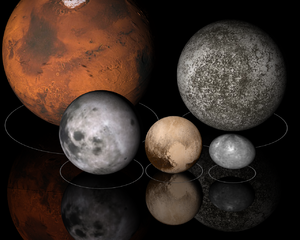行星
閱讀設定
天文學入面,行星(粵拼:haang4 sing1)係圍住恆星公轉、唔識發光嘅星球。由於行星質量又比恆星少好多,核心無核聚變,所以行星通常都唔會發可見光。
好耐好耐之前人就知道水星、金星、火星、木星、土星存在,爾五粒星響夜晚嘅天好光吓,用眼睇得見,而佢哋響天上「行」得好特別,有時向前行;有時打倒退。16世紀後,人類亦明白人住嘅地球都係一粒行星,之後嘅幾百年,發現埋天王星、海王星、冥王星、小行星。20世紀尾到依家,重發現太陽系之外嘅恆星系統都有行星,確定咗嘅差唔多有一百粒。咁多百年來,行星一直無正式嘅定義,2006年8月24日舉行嘅第 26 屆國際天文學聯會天文學家經過幾輪投票之後,終於為行星落咗個科學定義。
定義
[編輯]内文:2006年行星重新解釋
2006年8月24號喺捷克首都布拉格舉行嘅第 26 屆國際天文學聯會畀行星嘅定義:
太陽系
[編輯]其他系
[編輯]太陽系嘅行星
[編輯]


根據國際天文聯會畀行星嘅定義,太陽系有八粒行星,通稱八大行星,由近太陽講起:
- (
 ) 水星,無天然衛星
) 水星,無天然衛星 - (
 ) 金星,無天然衛星
) 金星,無天然衛星 - (
 ) 地球,有一粒已知嘅衛星
) 地球,有一粒已知嘅衛星 - (
 ) 火星,有兩粒已知嘅衛星
) 火星,有兩粒已知嘅衛星 - (
 ) 木星,有 63 粒已知嘅衛星
) 木星,有 63 粒已知嘅衛星 - (
 ) 土星,有 62 粒已知嘅衛星
) 土星,有 62 粒已知嘅衛星 - (
 ) 天王星,有 27 粒已知嘅衛星
) 天王星,有 27 粒已知嘅衛星 - (
 ) 海王星,有 13 粒已知嘅衛星
) 海王星,有 13 粒已知嘅衛星
舊時有九大行星,重包括冥王星,但自從2006年改咗行星定義之後,就降做矮行星。
分類
[編輯]太陽系嘅行星用佢哋嘅成份來分類:
- 類地行星:似地球嘅行星,成份係石頭:水星、金星、地球、火星。 如果包埋矮行星,穀神星會計埋,其餘三粒小行星好可能計埋。
- 類木行星:似木星嘅行星,主要成份係氣體,大過類地行星好多好多,有木星、土星、天王星、海王星。
特性
[編輯]| 行星特性 | |||||||||||
|---|---|---|---|---|---|---|---|---|---|---|---|
| 名 | 赤道 直俓* |
質量* | 軌道半俓 (AU) |
軌道週期 (年) |
軌道傾斜角 (°) |
軌道 離心率 |
自轉週期 (日)** |
衛星 | 環 | 大氣成份 | |
| 類地行星 | 水星 | 0.39 | 0.06 | 0.39 | 0.24 | 3.38 | 0.206 | 58.64 | 無 | 無 | 無咁濟 |
| 金星 | 0.95 | 0.82 | 0.72 | 0.62 | 3.86 | 0.007 | -243.02 | 無 | 無 | CO2, N2 | |
| 地球 | 1.00 | 1.00 | 1.00 | 1.00 | 7.25 | 0.017 | 1.00 | 1 | 無 | N2, O2 | |
| 火星 | 0.53 | 0.11 | 1.52 | 1.88 | 5.65 | 0.093 | 1.03 | 2 | 無 | CO2, N2 | |
| 類木行星 | 木星 | 11.21 | 317.8 | 5.20 | 11.86 | 6.09 | 0.048 | 0.41 | 63 | 有 | H2, He |
| 土星 | 9.41 | 95.2 | 9.54 | 29.46 | 5.51 | 0.054 | 0.43 | 56 | 有 | H2, He | |
| 天王星 | 3.98 | 14.6 | 19.22 | 84.01 | 6.48 | 0.047 | -0.72 | 27 | 有 | H2, He | |
| 海王星 | 3.81 | 17.2 | 30.06 | 164.8 | 6.43 | 0.009 | 0.67 | 13 | 有 | H2, He | |
*地球為 1,其他係相對值。**負數值係反方向轉咁解。
矮行星
[編輯]内文:矮行星
| 矮行星特性 | ||||||||||
|---|---|---|---|---|---|---|---|---|---|---|
| 名 | 赤道 直俓* |
質量* | 軌道半俓 (AU) |
軌道週期 (年) |
軌道傾斜角 (°) |
軌道 離心率 |
自轉週期 (日)** |
衛星 | 環 | 大氣成份 |
| 穀神星(Ceres) | 0.08 | 0.0002 | 2.76 | 4.60 | 10.59 | 0.080 | 0.38 | 無 | 無 | 無 |
| 冥王星(Pluto) | 0.18 | 0.0022 | 39.48 | 248.09 | 17.14 | 0.249 | -6.39 | 3 | 無 | 無咁濟 |
| 鬩神星(Eris) | 0.19 | 0.0025 | 67.67 | ~557 | 44.19 | 0.442 | ~0.3 | 1 | 無 | 無咁濟 |
*地球為 1,其他係相對值。**負數值係反方向轉咁解。



